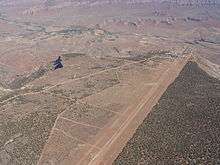Hurricane Supersonic Research Site


The Hurricane Supersonic Research Site (HSRS) on Hurricane Mesa was a USAF launch complex with a rocket research track that launched a rocket ejection seat from a supersonic sled. The track's 12,000 ft (3,700 m) "of continuously welded, heavy-duty crane-rails aligned to within plus or minus one-tenth inch tolerance [was] the longest" in the US (cf. the shorter 1954 Holloman Rocket Sled).[1] Coleman Engineering Company was contracted for $2 million in June 1954[2] and constructed the Supersonic Military Air Research Track (SMART), mechanical arresting gear (water brakes with 34 tons of force), retro rockets, and photographic/telemetering facilities. Coleman was also contracted for operations on November 30, 1955,[1] and achieved a "world land speed record [using] a 9,400-pound sled rocketing down the track at 1,800 miles per hour." The numerous test facilities included a powered comparator for high-speed motion pictures, a 1956 IBM 706 computer, and 1960 Bendix G-15 computer. Control of the site transferred from Indian Springs Air Force Base on November 6, 1957, and from Wright-Patterson AFB to Edwards AFB on March 9, 1962[3]—the base was placed on standby in December 1961,[1] and was closed on June 20, 1963.[3]
The 3,500.78-acre (1,416.72 ha) Formerly Used Defense Site (J08UT0026) initially transferred to Stanley Aviation and was leased to Sacol, Inc. on May 21, 1965.[4] Adjacent to the Hurricane Mesa Airport (37°14′59″N 113°12′31″W / 37.24972°N 113.20861°W[5]), the privately owned Hurricane Mesa Test Facility is owned and managed by the United Technologies Aerospace Systems division of the United Technologies Corporation.
References
- 1 2 3 "Brief Histories of Three Federal Military Installations in Utah: Kearns Army Air Base, Hurricane Mesa, and Green River Test Complex" (PDF). Utah Historical Quarterly. Utah State Historical Society. 34 (2). Spring 1966. Archived from the original (pdf) on 2013-10-29. Retrieved 2013-09-12.
- ↑ Project HSRS Formerly Project SMART: Its History and Its Mission (typescript) (Report). c. 1960.
- 1 2 Mueller, Robert (1989). Air Force Bases (PDF) (Report). Volume I: Active Air Force Bases Within the United States of America on 17 September 1982. Office of Air Force History. p. 600. ISBN 0-912799-53-6. Retrieved 2013-08-15.
Utah Fuel Company, a subsidiary of the Denver and Rio Grande Western Railroad ... In 1901 the Denver and Rio Grande Railroad purchased the Rio Grande Western, which owned Utah Fuel Company. Utah Fuel was eventually sold at public auction in 1918. ... In 1883 the Denver and Rio Grande Railroad completed its line into eastern Utah ... in 1888 Utah Fuel Company, which eventually took over Pleasant Valley Coal Company... In 1950 Kaiser purchased all assets of Utah Fuel Company ... A Pony Express station was established at Echo and another one 16 miles to the east at Castle Rock. ... Nearby ran a single track of the Union Pacific Railroad that had been constructed in 1869. ... Echo Canyon — which has had tribes of Indians, fur trappers, the Donner-Reed party, pioneers, the Pony Express, stagecoaches ... Great American Desert ...
- ↑ http://www.corpsfuds.org/php/siteindex.php?site=J08UT0026&state=Utah
- ↑ "Hurricane Mesa Airport (1434542)". Geographic Names Information System. United States Geological Survey. Retrieved 2013-09-15.